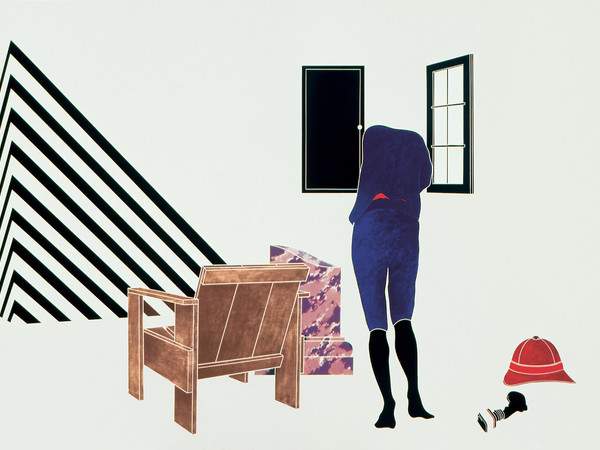An exhibition in Milan showcases works from the 1970s by Emilio Tadini
Twenty years after the death of Emilio Tadini (Milan, 1927 - 2002), from Feb. 4 to March 5, 2022 at Milan ’s Gió Marconi Gallery is hosting Viaggio in Italia, an exhibition featuring works from the Milanese artist’s eponymous series from the early 1970s, first exhibited in 1971 by Studio Marconi. On the occasion of the exhibition, the new publication Emilio Tadini. The Reality of the Image 1968-1972 by Francesco Guzzetti, published by Fondazione Marconi / Mousse Publishing.
Emilio Tadini’s entire oeuvre, seemingly simple and immediate, offers multiple levels of interpretation: images emerge in a Freudian procedure of relationships and associations between dreamlike elements, everyday objects, anonymous and often faceless characters. Considered one of the most original figures in the post-World War II Italian cultural debate, Tadini adopted aspects of Pop language when the movement was already in decline, but his interest in the unconscious and the irrational led him to depict scenes of fragmentation and alienation reminiscent of Surrealism, with references as much to the Metaphysics of de Chirico as to the psychoanalysis of Lacan and Freud. Thus was born his Integral Realism.
Tadini has always had a serial approach to painting: from one image others spring forth, by progressive modification and alteration. Each time the artist produces a story, so much so that his painting grows in cycles, like a series of serialized novels, in which the laws of space and time and those of gravity are totally annulled.
Ubiquitous in the Viaggio in Italia series are the solitary, headless figures, already the protagonists of some of his early cycles of work, such as L’uomo dell’organizzazione (1968) or Vita di Voltaire (1967). Tadini’s creatures consist of bodies, movements and gestures but have neither faces nor heads: recalling Brecht’s epic theater, they add to the alienating effect of his works.
For an intellectual like Tadini, it seems almost impossible to look at Journey to Italy without thinking of Johann Wolfgang Goethe’s travelogue of the same name, in which the author describes his Italian sojourn from September 1786 to May 1788. A remarkable similarity between the two Italian Journeys is that Goethe, as well as Tadini, relies heavily on self-made images and his own visual repertoires: while visitingItaly, Goethe drew and produced numerous watercolors, while Tadini drew on a myriad of photographic images that he took and neatly archived for his paintings. The preparatory drawings and photographs are the first references of what would eventually be translated into text and onto canvas.
In one of the large paintings in the Viaggio in Italia series, Tadini cites Johann Heinrich Wilhelm Tischbein’s well-known watercolor Goethe am Fenster der römischen Wohnung am Corso, depicting Goethe standing with his back turned looking out the window. Tadini’s version shows both open and closed windows and gives the figure, standing without a head, the exact same outfit as the original - long socks, a pair of breeches and shirt.
In his journal, Goethe was particularly attentive to ancient Italian architecture, the geography, geology and botany of the peninsula, and reported multiple mineralogical observations. Tadini seems to reflect that interest in his recurring representations of architectural forms, cylinders, cubes, and pyramids of different types of marbles and rocks.
As in previous works, Tadini uses recurring motifs: a pyramidal element with black and white stripes, a standing headless female figure, a telephone, a colonial hat or a red lipstick. Through his choice of objects he makes his journey more concrete. His Italian journey is about contemporary everyday life, as suggested by the telephone, the (ci)nema letters, the elegant women’s clothes, the various design objects or the Calder sculpture.
While including references to antiquity, Tadini’s Italian Journey also touches on the fields of design, art, culture, fashion and style. His Italian vision combines the past with modernity. This strictly object-oriented viewpoint, in which reflection on different kinds of objects leads to better self-knowledge, brings Goethe’s Journey to Italy closer to that of Tadini, who argued “Art as a means of intensifying the perceptibility of things.” Georg F. Schwarbaner sums it up in a few words, “Every object, every symbol, every fragment of a sentence and a word has its own specific meaning. Tadini’s works resemble an encyclopedia of images of our century.”
For all information, you can visit the official website of the Giò Marconi Gallery.
Pictured: Emilio Tadini, Viaggio in Italia (1970; acrylic on canvas, 200 x 300 cm). Photo by Emilio Tadini Archive, Milan
 |
| An exhibition in Milan showcases works from the 1970s by Emilio Tadini |
Warning: the translation into English of the original Italian article was created using automatic tools. We undertake to review all articles, but we do not guarantee the total absence of inaccuracies in the translation due to the program. You can find the original by clicking on the ITA button. If you find any mistake,please contact us.





























